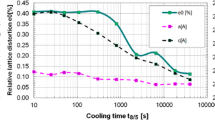Diagnostics of the structure of materials is necessary for determining subsequent technological operations in the production of finished products. In the present paper, we propose to use synchrotron radiation for investigating the phase composition of metal-ceramic coatings with a titanium alloy as a matrix and powdered titanium boride as reinforcing elements. A comparison of the results obtained from the diffraction of x-ray tube radiation (Cu) and synchrotron radiation has shown that when it is necessary to determine the phases containing light elements (in the present case B), diffraction of synchrotron radiation makes it possible to unambiguously reveal TiB in the resulting coating, whereas diffraction of x-ray tube radiation could not allow unambiguous interpretation of results. Thus, the advantage of the synchrotron radiation in diffraction studies has been shown.
Similar content being viewed by others
References
Gokuldoss Prashanth Konda, Sri Kolla, and Jürgen Eckert, Additive manufacturing processes: Selective laser melting, electron beam melting and binder jetting-selection guidelines, Materials. MDPI AG, 10, No. 6 (2017); https://doi.org/10.3390/mal0060672.
V. M. Fomin, A. A. Golyshev, A. G. Malikov, et al., Creation of a functionally gradient material by the selective laser melting method, J. Appl. Mech. Tech. Phys., 61, No. 5, 878–887 (2020).
Yuze, Li, Miha Založnik, Julien Zollinger, et al., Effects of the powder, laser parameters and surface conditions on the molten pool formation in the selective laser melting of IN718, J. Mater. Proc. Technol., Elsevier Ltd, 289, Article ID 116930 (2021).
Muhammad D. Hayat, Harshpreet Singh, Zhen He, et al., Titanium metal matrix composites: An overview, Compos. Part A: Appl. Sci. Manuf., 121, 418–438 (2019).
K. Morsi, Review: titanium–titanium boride composites, J. Mater. Sci., 54, No. 9, 6753–6771 (2019).
A. Golyshev and A. Orishich, Microstructure and mechanical characterization of Ti6–Al4V–B4C metal ceramic alloy, produced by laser powder-bed fusion additive manufacturing, Int. J. Adv. Manuf. Technol., 109, Nos. 1–2, 579–588 (2020).
Nahum Travitzky, Fu Zongwen, A. Knyazeva, et al., Reactive synthesis of ceramic–metal composites, Adv. Eng. Mater., 20, No. 8, Article ID 1800324 (2018).
Haibo Feng, Qingchang Meng, Yu Zhou, et al., Spark plasma sintering of functionally graded material in the Ti–TiB2–B system, Mater. Sci. Eng. A, 397, Nos. 1–2, 92–97 (2005).
Y. S. Tian, Growth mechanism of the tubular TiB crystals in situ formed in the coatings laser-borided on Ti–6Al–4V alloy, Mater. Lett., 64, No. 22, 2483–2486 (2010).
Hooyar Attar, Konda G. Prashanth, Lai Chang Zhang, et al., Effect of powder particle shape on the properties of in situ Ti–TiB composite materials produced by selective laser melting, J. Mater. Sci. Technol., Chin. Soc. Metals, 31, No. 10, 1001–1005 (2015).
S. C. Tjong and Yiu Wing Mai, Processing–structure–property aspects of particulate- and whisker-reinforced titanium matrix composites, Compos. Sci. Technol., 68, Nos. 3–4, 583–601 (2008).
A. Golyshev, A. Malikov, A. Orishich, et al., The effect of using repetitively pulsed laser radiation in selective laser melting when creating a metal-matrix composite Ti–6Al–4V–B4C, Int. J. Adv. Manuf. Technol., 117, Nos. 5–6, 1891–1904 (2021).
Hooyar Attar, Matthias Bönisch, Mariana Calin, et al., Selective laser melting of in situ titanium–titanium boride composites: Processing, microstructure and mechanical properties, Acta Mater., 76, 13–22 (2014).
Hailiang Li, Dechang Jia, Zhihua Yang, et al., Effect of heat treatment on microstructure evolution and mechanical properties of selective laser melted Ti–6Al–4V and TiB/Ti–6Al–4V composite: A comparative study, Mater. Sci. Eng.: A, 801, Article ID 140415 (2021).
Dongdong Gu, Yves Christian Hagedorn, Wilhelm Meiners et al., Nanocrystalline TiC reinforced Ti matrix bulk-form nanocomposites by Selective Laser Melting (SLM): Densification, growth mechanism and wear behavior, Compos. Sci. Technol., 71, No. 13, 1612–1620 (2011).
V. M. Fomin, A. A. Golyshev, V. F. Kosarev, et al., Deposition of cermet coatings on the basis of Ti, Ni, WC, and B4C by cold gas dynamic spraying with subsequent laser irradiation, Phys. Mesomech., 23, No. 4, 291–300 (2020).
Author information
Authors and Affiliations
Corresponding author
Additional information
Translated from Inzhenerno-Fizicheskii Zhurnal, Vol. 95, No. 7, pp. 1794–1800, November–December, 2022.
Rights and permissions
Springer Nature or its licensor (e.g. a society or other partner) holds exclusive rights to this article under a publishing agreement with the author(s) or other rightsholder(s); author self-archiving of the accepted manuscript version of this article is solely governed by the terms of such publishing agreement and applicable law.
About this article
Cite this article
Fomin, V.M., Ancharov, A.I., Bulina, N.V. et al. Prospects of Using Synchrotron Radiation for Diagnostics of the Structural-Phase Composition of Composite Materials. J Eng Phys Thermophy 95, 1746–1752 (2022). https://doi.org/10.1007/s10891-022-02645-1
Received:
Published:
Issue Date:
DOI: https://doi.org/10.1007/s10891-022-02645-1




